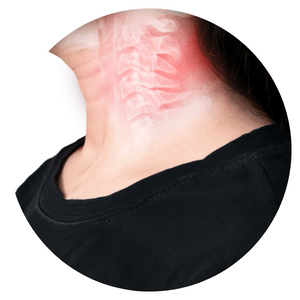$99 Chiropractic First Visit + Treatment
Now Accepting All New Patients
Let’s get you out of pain. Welcome to Sydney Spinal Care. Take advantage of our $99 New Patient Consultation (includes your First Chiropractic Adjustment as well). Normal visits only $70.
Seek a Chiropractor for Spinal Care
Hi, I’m Dr. Matthew Alch (Chiropractor) and I’m your local Chiropractor. Find out more about spondylosis treatment on this page, or book your chiropractic consultation now.
Spondylosis is a degenerative condition affecting the spine’s discs, joints, and bones. It is a common cause of chronic pain and reduced mobility. Spondylosis often affects:
- Neck – called cervical spondylosis
- Lower back – called lumbar spondylosis
- Middle back – called thoracic spondylosis.
To know more about your condition, contact Dr. Matthew Alch (chiropractor) from Sydney Spinal Care today.
Dr. Matthew Alch (Chiropractor) – Sydney Spinal Care
Effective spondylosis treatment may help to alleviate pain and improve mobility.
What is Spondylitis?
Spondylitis refers to the inflammation of the spinal joints, which can be triggered by factors such as infection, injury, or the natural ageing process.
Symptoms of Spondylosis
Individuals with spondylitis often experience symptoms like persistent back pain, hip discomfort, stiffness, and reduced mobility.
This condition can lead to symptoms such as:
- Chronic neck and back pain
- Stiffness and reduced range of motion
- Nerve compression leading to tingling, numbness, or weakness in the limbs
- Headaches or discomfort radiating from the neck
Spondylosis Treatments
Treatment options typically include medications such as antibiotics or anti-inflammatory drugs, physical therapy to maintain mobility, and, in some cases, surgical intervention.
Different Types of Spondylitis
What is ankylosing spondylitis?
A prevalent form of spondylitis is ankylosing spondylitis, a type of inflammatory arthritis that specifically affects the spine and sacroiliac joints. Ankylosing spondylitis can lead to pain and stiffness in the back and neck.
In progressive cases, ankylosing spondylitis can result in vertebrae fusion, leading to a rigid posture or hunch.
The term ‘ankylosis’ refers to a condition where the spinal bones fuse.
Ankylosing spondylitis treatment can involve medications, physical therapy, lifestyle modifications, and surgery. They are all essential for managing pain, preventing stiffness, and promoting spinal mobility.
What is lumbar spondylosis?
Lumbar spondylosis is a degenerative condition affecting the lower spine (lumbar region). It is typically associated with ageing. Lumbar spondylosis involves the wear and tear of the intervertebral discs, and facet joints of the lumbar spine. This can lead to changes such as disc degeneration, bone spurs (osteophytes), and the narrowing of the spinal canal (spinal stenosis).
Lumbar spondylosis treatment may include pain management, physical therapy, lifestyle modifications, and surgical intervention in the lower back.
What is cervical spondylosis?
Cervical spondylosis is a degenerative condition affecting your cervical spine , or your neck. Your cervical spine refers to the upper portion of your spine.
Cervical spondylosis may be caused by wear and tear of the intervertebral discs and joints in the cervical spine, typically due to ageing. As the discs lose their moisture and elasticity, they shrink and become less flexible, leading to the development of bone spurs (osteophytes) and other changes that can compress the spinal cord or nerve roots.
Cervical spondylosis treatment may involve medications, lifestyle modifications, and surgery. Specific physical therapy may involve exercises to improve neck strength and flexibility and techniques to correct posture. Specific neck traction may also be recommended. This is a method to gently stretch the neck and relieve pressure on the spinal discs and nerves.
Spondylosis FAQs
What does spondylosis pain feel like?
The pain associated with spondylosis can vary depending on the severity and location of the condition, but generally includes:
- Localised pain. A constant, dull ache or sharp pain in the affected area of the spine (neck or lower back). This pain may be aggravated by certain movements or prolonged periods in one position.
- Stiffness. A feeling of stiffness in the spine, especially after periods of inactivity, such as waking up in the morning. This can make it difficult to move or turn your neck or back.
- Nerve pain. If the degeneration causes pressure on nearby nerves, you might experience radiating pain, numbness, or tingling in the arms (from cervical spondylosis) or legs (from lumbar spondylosis). This can also result in muscle weakness in severe cases.
- Headaches. In cases of cervical spondylosis, headaches might occur, especially if the degeneration affects the upper cervical vertebrae.
Is spondylosis the same as degenerative disc disease?
Spondylosis and degenerative disc disease (DDD) are related but distinct conditions that both involve the spine.
Spondylosis is a broader term that includes any type of spinal degeneration, whereas degenerative disc disease specifically refers to the degeneration of the intervertebral discs.
How can a chiropractor help with spondylosis?
When you visit a chiropractor, they can do a lot to relieve your pain and restore your function. Their goal is to reduce the pressure on your pinched nerves, herniated discs, scoliosis, and arthritis of the spine, as well as increase your range of motion. The result will be decreased spondylosis pain and a stronger body with improved posture.
Does spondylosis ever go away?
Healthcare providers can’t cure spondylosis, but they may help to keep it from getting worse.
Is walking good for spondylosis?
It’s important to regain movement and strength to support tissue healing and help you get moving again. You may not be able to return to your usual exercise levels immediately, and progress may be slow at first. However, gradually resuming normal activities is the best way to achieve good short- and long-term results after cervical spondylosis.
When exercising, listen to your pain levels, especially in the early stages. You may find that these exercises slightly increase your symptoms at the beginning. However, they should become easier over time.
What aggravates spondylosis?
Avoid sleeping where an air conditioner or fan blows directly on you. Keep your head straight while standing or walking, avoiding tilting it up or down. When reading, do not tilt your head down, as this increases the load on the neck muscles.
Lumbar spondylosis, degeneration in the lumbar spine, may cause pain in the back, buttocks, or legs, along with possible numbness and muscle weakness. These symptoms may worsen with activities such as lifting, bending, twisting, or sitting.
Get Directions
Sydney Spinal Care
Why Choose Sydney Spinal Care?
What sets us apart?
- Take advantage of our $99 New Patient Consultation (includes your first chiropractic adjustment as well).
- We’ll provide you with a full assessment of your case to determine if chiropractic can help you
- Our 25+ years experience means that we offer you a tried and true experience, backed by our reputation
- Instant health fund claims available on-site
- We are fully accredited with the Australian Health Practitioner Regulation Agency (AHPRA), as well as members of the Australian Chiropractors Association (ACA).
Our patient-centred approach here at Sydney Spinal Care will make sure you have a great chiropractic experience with us!
Get In Touch
Make a Booking
To know more about your condition, contact Dr. Matthew Alch (chiropractor) from Sydney Spinal Care today.
New Patients Helped
Combined Experience
Open Per Week


